Pig breeding at home
Breeding pigs is a lengthy process that needs to be prepared in advance. In this review, the basic rules that must be followed for the effective maintenance of pigs in households.
Pig Breeding for Beginners
At present, raising pigs is in great demand due to the products received, which will always be in demand regardless of pricing policy. In order to get the required amount of production, first you need to equip the pigsty, and then choose the breed. The arrangement of the pigsty does not require special costs for materials. You can start raising pigs with one individual, which over time can lead to offspring.

Where to start and what you need to breed pigs
They begin to think about how to breed piglets, from determining the place for the pigsty. Then you need to prepare all the equipment for caring for pigs. Next, you need to determine the breed for growing. Starting from the breed of piglets, arrange suitable housing for them.
The right breed choice
The choice of breed depends on the purpose for which you need an animal.
There are three types of directions in pig breeding:
- sebaceous;
- meat;
- universal.
Did you know? Pigs save lives because transplantation uses donor material from these animals.
Sebaceous rocks
This direction includes breeds in which the growth of muscle tissue ceases early, but the amount of subcutaneous fat (fat) increases. This type is not popular among pastoralists, but the yield of meat from such an animal is no less than from other types.
The following types of pigs belong to the greasy direction:
- Berkshire;

- Large black;
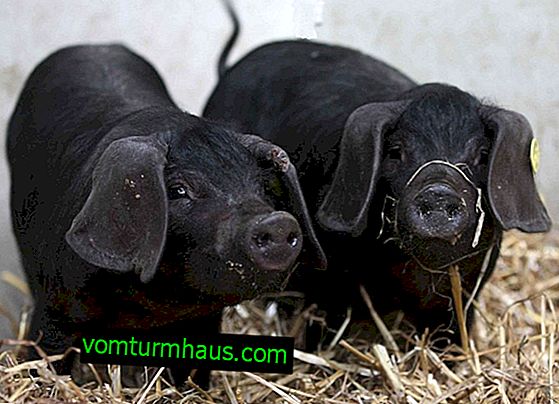
- Mirgorodskaya;

- Lithuanian;
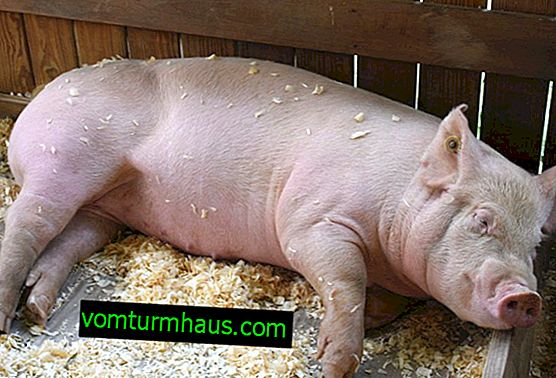
- Latvian;
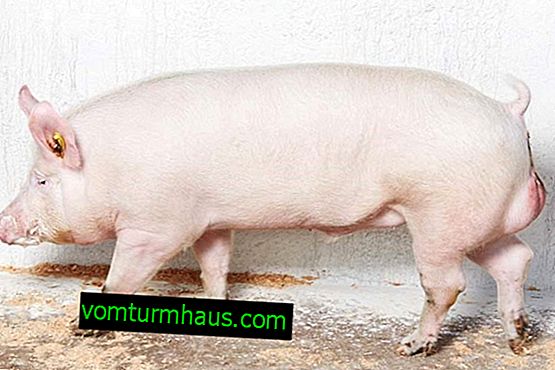
- North Caucasian.
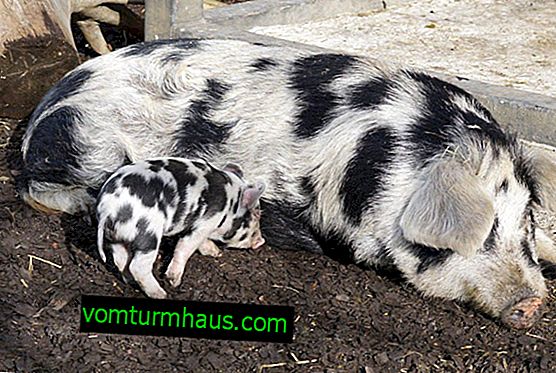
Meat breeds
The meat direction includes pigs that have less subcutaneous fat and a significantly larger increase in muscle mass than the previous direction.
The following breeds of pigs belong to the meat direction:
- Landras

- Duroc;
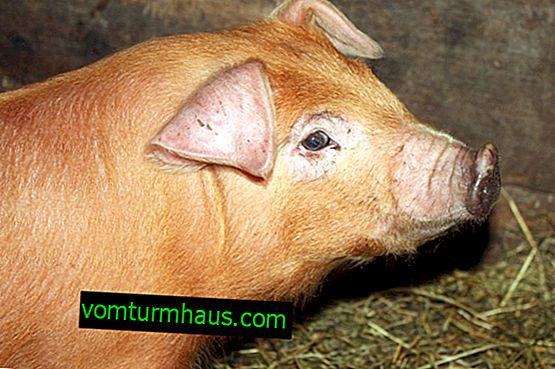
- Vietnamese
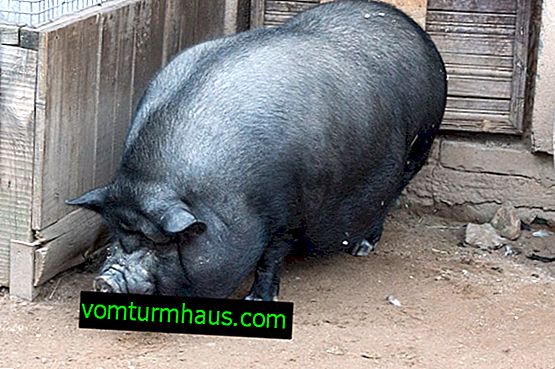
- Estonian.
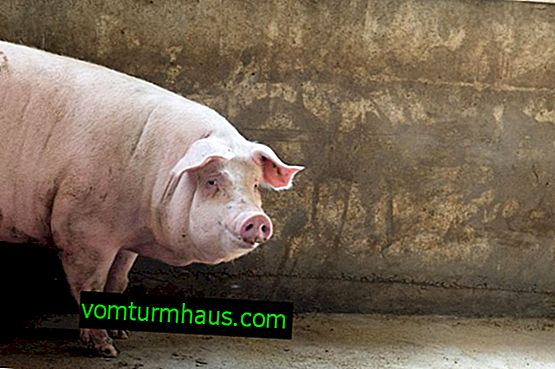
Universal breeds
A common trend among modern farmers. Such pigs can be fed for meat and fat.
The universal direction includes such breeds of pigs:
- Large white;
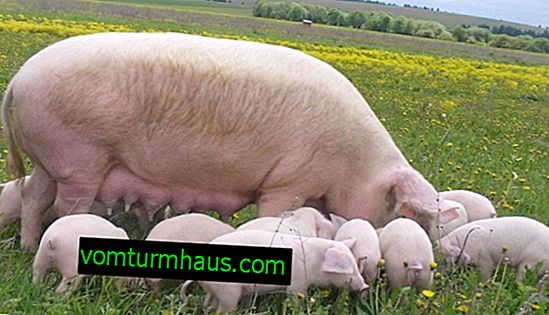
- Siberian North;

- Bretovskaya.

Pigsty and its features
The size of the pigsty and its arrangement directly depend on the breed, climatic conditions in which the herd will live, as well as the number of individuals in the livestock. If you plan to raise 1-2 animals, then for them you need to build a small building with a corral. One individual will need 2.5 m. If you plan to grow a livestock of 10 piglets, then the area for their placement should be 20x25 m. The pigsty should be warm, as pigs are heat-loving animals. In addition, you should carefully choose the material for construction. In a cold room, the pigs will gain weight poorly, since all the energy will be spent on warming. It is necessary to place the pigsty in a dry place without drafts.
Learn more about how to build a pigsty with your own hands.
In the pigsty, machines are installed, the depth of which is 2.5 m, each machine should contain:
- 5–6 piglets for feeding;
- male inseminator;
- sow.

Ventilation and lighting
With a lack of oxygen in piglets, growth retardation can occur, as well as various diseases that can lead to the death of a whole herd, so you need to install good, high-quality ventilation in the pigsty. In the summer, you need to open windows and doors - this is a great way to ventilate the room. But at the same time, it is necessary to ensure that there are no drafts, since pigs do not tolerate being in cold air. In winter, windows and doors cannot be opened, so metal pipes are installed for ventilation. They are mounted in windows or through an exhaust pipe.
Important! The ratio of the number of windows to the pigsty area should be 1:10.
To install additional lighting, it is important to know for what purpose pigs are raised. If you plan to contain pigs of meat-greasy or meat direction, you need to light the room well, if greasy direction - additional lighting is required to a minimum. Also, light affects the reproduction of animals: growing piglets in a dark pigsty will worsen sexual activity, and with it the ability to fertilize. In the summer, sunlight will suffice as lighting. In winter, daylight hours are extended with incandescent lamps.
There are several recommendations for lighting a pigsty:
- in machines where brood sows are grown, the daylight hours should be 18 hours, with a total lighting level of 15 lux;
- on the street where the pigs are fed - 12 hours, with a lighting level of 6–9 lux.

How and what to feed pigs
To get tasty meat and fat, you need to pay attention to feeding piglets. This is the main area of concern for the owner in the process of keeping pigs. You can choose the right food for individuals in the herd by analyzing the age, gender and direction of the pig. The diet of young animals will differ from the food of a ripened pig. You also need to remember that sows need more high-calorie and vitamin-enriched foods during the gestation period.
It is also necessary to calculate the cost of the purchase and self-preparation of feed. Compound feed is a guaranteed way to quickly increase the body weight of an animal. In addition, it contains much more nutrients than conventional root crops, so the meat of pigs that fed compound feeds is of high quality.
You will be interested to know all about pig feed.
The structure of the pig's body suggests the presence of a single chamber stomach. That is why it is important to exclude fiber from the feed, otherwise the animal simply will not be able to digest such food. Based on this feature, give only concentrated and structured feeds for food. Greens in the feed should be in minimal amounts.
You can use classic feeding, which contains mixed food waste from boiled vegetables, herbs and grains. You can also choose feeding using dry food, which includes ground grain with the addition of pea flour, oilcake, vitamin and mineral supplements. With dry feeding, you often need to water the animals, because with a lack of water they will suffer from diarrhea. The advantage of this type is considered not so sharp smell of animal feces.

Intensive fattening pigs
Fattening piglets depends on what product you want to get - tasty, juicy meat or fat. Intensive fattening is done differently for each direction.
Consider the feeding of each type separately:
- Meat type. Fattening of this type of pig starts from 2-3 months and ends by 5-7 months. To do this, clearly follow the feeding formula. If you follow the rules of feeding, by 6 months the animal will weigh 80-120 kg. At the same time, the height of the fat on the back will not exceed 2–4 cm. The desired result can be achieved if there is an increased amount of protein in the feed. The diet of meat pigs should consist of green grass, peas, legumes, skim milk. When the animal weighs 70 kg, the diet is adjusted. You need to add more concentrated succulent feed: up to 10-15 kg, as well as 10-25 g of salt and 5-15 g of chalk per day.
- Universal type. Fattening of this type begins from 2-3 months and ends by 5-7 months. Fattening is divided into two parts and lasts until a weight of 80–100 kg is reached. Part one lasts for three months. On a day, the animal gains 450 g. Part two lasts 3-4 months. On a day, the animal adds up to 600 g. The diet consists of beans, peas, millet, barley, corn and rye. In order not to spoil the taste of meat, it is necessary to exclude from the food products such as oilcake, bran, soy and fish waste.
- Greasy type. In order to ultimately get the required amount of fat, it is necessary to use feeds that contain a large amount of carbohydrates. Pig diets should include beets, corn, wheat, and boiled potatoes. Increase subcutaneous fat gradually. For this, the consumed amount of corn and wheat per day should be 3 kg.
Important! Pig is slaughtered when its weight reaches 170-200 kg, and the ratio of meat and fat is 30:50.
Pig breeding methods and techniques
In pig farming, there are various methods and technologies for raising pigs.
There are two breeding methods - pure and crossbreeding:
- Pure breeding is used to produce purebred pigs or new breeds. But with an error in choosing a female or male, a sick or premature brood can result. In order to avoid problems with litter, you need to change the males every two years.
- The second method consists in crossing unproductive sows with highly productive males. Also, using this method, you can improve the taste of pig meat or breed new breeds.

Proper exploitation of males, balanced nutrition, as well as keeping in comfortable conditions increase the duration of the ability to breed in pigs. The male is capable of breeding for 8–9 years. If improperly maintained, the animal will breed only up to 4 years.
Did you know? Studies have shown that swingers are much smarter than dogs, and inferior in intellectual abilities only to humans, dolphins and monkeys. The first cage is carried out with males who are already a year old and who have a weight of 150 to 180 kg. Performing mating earlier is not recommended, as piglets can be born lethargic and weak. Based on this, males, starting from the age of 4-6 months should be kept separate from sows. During this period, they begin puberty.
A young male goes through 6–12 incidents per month, a 2-year-old male mates 10–20 times a month, and males aged 3–4 years can cover females up to 12–25 times. From 10 to 11 months, sows weighing 110–140 kg are sent for mating. If the uterus has a delay in development and growth, then the cage should be postponed for a month. The sow can give offspring for 5-6 years. From one uterus per year, two surveys can be obtained.
In order to obtain the desired result for piglet breeding, it is important to prepare the right products for feeding the animal in advance, as well as provide young piglets and adults with territory for living and walking.
In pig breeding, two types of mating are used:
- artificial insemination;
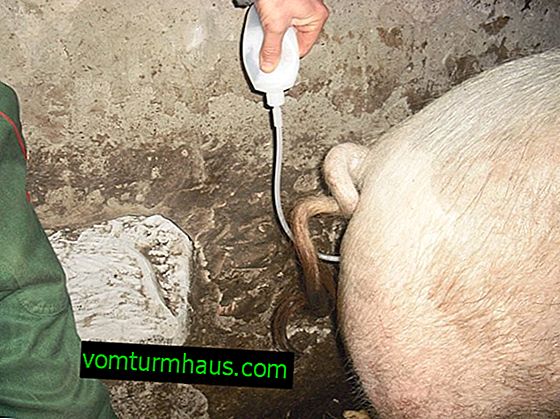
- manual mating.

Sows are inseminated during the hunting period - sexual desire. It occurs after the piglets are removed from the pigsty. Female has estrus every 21 days. It is important to observe the sow, so as not to miss a short period of estrus - 1-2 days. Do not forget that you need to fertilize the female two times: the first time as soon as the estrus has begun, and the second to repeat 10-15 hours after the first insemination.
In winter, the attraction of the uterus is almost not noticeable, in order to identify it, you need to run the male to the sow when walking the pigsty for 1-2 hours in the morning and evening. The cage is carried out in the machine, where the sow is first bred, and then the male. If the male is heavier than the uterus, mating is done in a random machine. At the time of mating, the room should be quiet, it is necessary to limit the entry of strangers.
Artificial insemination is much more commonly used in agricultural farms. Using this technique, in a short period of time, the productive qualities of sows and males can be improved. This method significantly reduces the cost of maintaining pigs, as well as the cost of finished products. On small farms, the procedure should be organized, thinking in advance that the future offspring should have its own separate place for sleeping and eating.
Did you know? During the season, the male can fertilize from 100 to 150 queens and get 25, 000 piglets from them per year.
Pig regulations
Pigs are kept in farms of various sizes, as this is a very popular animal in farming. You must adhere to the basic rules for the care of animals in order to ultimately get a quality product.
In the private sector
To breed piglets, it is important to build a pigsty for livestock, choose the right feed and give pigs for vaccination on time.

- feed for pigs should be safe for both animals and others;
- the pigsty must be fenced so that other animals cannot enter it, and also so that the pig does not run away;
- manure can be stored only in specially designated premises;
- it is necessary to keep the pig house clean. To do this, you can install the sewer and water supply directly in the pigsty;
- vaccination should be carried out by a specialist, and the owner must follow all the instructions of the doctor.
In the village
The content of piglets in the village differs from growing in the private sector by the size of the farmer’s plot, as well as the ability to give animals more sunlight and walks in the fresh air.
The basic rules remain unchanged:
- the pigsty should be kept clean and tidy;
- piglets should be vaccinated, for which you need to call a veterinarian;
- feed should be suitable for the breed of pig and not contain harmful substances.



















